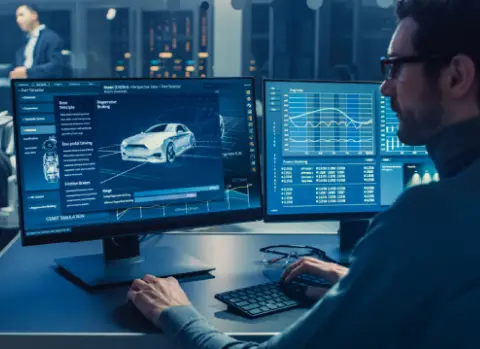The challenges in the automotive industry are driven by persistent parts shortages, particularly the chip crisis, which disrupts factory output worldwide. Limited inventory visibility and inaccurate procurement cost assessments strain financial stability. Additionally, frequent recalls from faulty airbags to brake fluid leaks damage brand reputation and impose hefty retrofitting expenses. Weak quality control and the use of subpar materials from suppliers further contribute to product reliability issues, compounding industry-wide concerns.
Top automotive industry challenges

The problems in the automobile industry stem from a major transformation, where traditional manufacturers face declining margins while investing in electromobility and customer-focused innovations. Key challenges include supply chain disruptions, rising energy costs, labor shortages, and economic instability. As the combustion engine era fades, new competitors emerge, reshaping the market through mergers and acquisitions.
Input shortages continue to jitter global automotive OEMs
Automotive sales remain in the fast lane on the back of strong demand, so the need for components, such as semiconductors, is unlikely to ease anytime soon, though fabs worldwide are running at 70-80% capacity. The challenges in the automotive industry go beyond logic chips. Widespread dockworker shortages mean auto businesses will have to cope with supply chain slowdowns and parts shortages resulting from port congestion. Lithium battery packs most EVs run on are shipped over long distances from China, the world leader in battery modules. Five countries account for most of the world’s lithium mineral output, and, despite a three-fold jump in production in the last decade, the demand-supply gap will likely be more than 1 million metric tons by 2035.
Opaque supply chains add to the industry’s woes
The problems in automobile industry extend beyond parts scarcity, as many companies struggle with fragmented supply chain visibility. Inaccurate data increases risks such as pilferage, unauthorized sales, and counterfeit product substitutions. Limited insight into supply chain interactions prevents valuable collaboration with suppliers, leading to missed opportunities and strained relationships. These inefficiencies ultimately threaten business performance and profitability.
Businesses struggle with quality issues, full traceability remains elusive
Quality is a key issue plaguing most automakers, and costly recalls are becoming all too common. On the one hand, tracing and tracking products back to suppliers is a weak spot in supplier quality management. Moreover, in the race to meet deadlines, at least some suppliers feel compelled to give quality concerns a wide berth. Even seemingly modest quality variations might necessitate reworking and error correction at the client site, leading to additional costs by way of parts sorting, inspection, reworking, and reshipment, and all this is unavoidable in the interest of brand reputation and user safety. Auto manufacturers are forever chasing daunting deadlines, and defective parts can only damper these efforts. So, this, without a doubt, figures among the biggest challenges in the automotive industry.
Economic and labor impacts
The automotive industry is a crucial source of employment and economic activity. The manufacturing of cars involves a complex network of organizations dedicated to designing, developing, manufacturing, and selling vehicles. Economic disruptions in major manufacturing countries like the US, Mexico, Japan, South Korea, and China can lead to severe local and national economic consequences.
Component shortages and rising costs
The challenges in the automotive industry include ongoing shortages of critical components like semiconductors, magnesium, and silicon, worsened by the pandemic and geopolitical tensions. Rising energy costs for electricity and gas are increasing production expenses, while transportation disruptions in maritime and road logistics further strain supply chains. These problems in automobile industry have led to project delays and stalled investments for manufacturers.
Market uncertainty
The industry is grappling with lower economic growth, reduced vehicle financing, high energy costs, and ongoing component shortages. These factors contribute to a global vehicle shortage, leading to increased prices for both new and used cars. Many manufacturers prioritize producing high-margin vehicles, like SUVs and luxury models, further limiting market availability. This shortage impacts economic growth and employment, while an aging vehicle fleet increases accident rates.
Evolving consumer preferences
Consumers, especially younger, tech-savvy individuals, are driving demand for sustainable and convenient mobility solutions. There is a growing preference for customized vehicles and those with higher fuel efficiency and lower emissions, such as battery electric vehicles (BEVs) and plug-in hybrid vehicles (PHEVs). Manufacturers are adapting by offering more configuration options in smaller production volumes.
Workforce changes
The automotive sector needs to replace retiring workers (over 25% of manufacturing workers are over 55) while retaining institutional knowledge for new employees. The incoming millennial workforce expects flexible benefits and a good work-life balance, requiring companies to adjust their workplace practices
Stay ahead of automotive industry challenges with SpendEdge’s tailored solutions. Request your free proposal today and transform your supply chain strategy…
The future: Automotive product innovation
- The thought of the next billion automobile owners/users is either the most intriguing or the most terrifying vision for the near future, depending on how you look at it. Future global demand for cars could possibly outstrip today’s levels, creating immense business opportunities. However, the combination of ride-sharing systems like Uber and autonomous vehicles capable of driving themselves will have very profound effects on automobile manufacturing, usage, sales, and ownership patterns. At least in dense urban environments, the result is very likely to be a large proportion of individuals who opt to use shared vehicles rather than user-owned cars.
- Surveys show that many young adults have little interest in owning a car of their own, which is vastly different from the attitude held by previous generations. Major automobile makers, when looking to the future, talk in terms of delivering “mobility services” as much as automobiles, while they consider the looming effects of car-sharing and ride-on-demand services.
- Car safety has made dramatic progress in recent years, mainly by adopting innovations such as backup cameras, anti-skid, advanced brakes, and collision avoidance systems. Now, all major car makers are heavily invested in technologies that will enable cars to largely drive and monitor themselves. A major technology focus is vehicles that can communicate with each other while utilizing advanced technologies to safely stay in lanes, regulate speeds, and apply emergency braking. This is referred to as vehicle-to-vehicle communications and is part of an overall digital strategy known as ITS, or intelligent transportation systems.
- Automobiles have become high-powered computers on wheels, as many automotive systems are now controlled by semiconductors and software. At the same time, auto makers are finding innovative ways to use the latest in wireless and smartphone technologies, including apps, to enhance the entertainment, information, and communications capabilities of vehicles. Automotive “infotainment” has become a dominant theme.
- However, the industry faces several challenges. Electromobility is on the rise, pushing traditional combustion engine vehicles to adapt or phase out. The automobile industry must navigate supply problems and skilled labor problems that impact production. The current economic scenario and political scenario also influence market dynamics, affecting competitors and their market positions.
- Manufacturing and assembly processes are strained due to inventory management issues and the global chip shortage. Factories must optimize the use of components and elements to keep up with demand. Leading organizations in the industry are continually innovating to stay ahead, but they must address these supply chain and labor challenges to maintain their competitive edge. The future of the automobile industry is a blend of immense opportunities and significant challenges. Embracing innovations and adapting to new market realities will be crucial for success.
Ways to address the challenges and threats encircling the automotive industry
In view of the threats to the automotive industry, and as chip shortage threatens to stretch into 2024, upsetting delivery schedules, auto business may choose to ship vehicles without certain add-on features (e.g., advanced driver assistance system powered by augmented reality). Buyers will still have the option to plug them in later. Rewriting vehicle software to get more out of available chips is the other possibility OEMs are exploring. Besides, automakers are securing access to critical materials (e.g., lithium) by inking exclusive contracts for battery-grade lithium with large producers of the metal.
Adoption of more roll-on roll-off (RoRo) ships, which can easily onboard and discharge wheeled cargo, and large economy containers will help ease the pressure on ports. With web-enabled smart devices embedded with sensors, businesses can measure and monitor various aspects of the assets in transit (e.g., temperature, location, transit speed) in real time and gain deeper and clearer views of the supply chain to alleviate the risk of supply disruptions. In view of the spate of vehicle recalls, auto manufacturers must strive to not only meet quality management standards (e.g., ISO/TS 16949) but also ensure their suppliers embrace such defect-prevention specifications without fail.
Why choose SpendEdge?
SpendEdge Solutions
- Improve demand forecasting accuracy
- Get direct line of sight to supply-side tasks
- Track supplier performance to manage quality
Improve demand forecasting accuracy to contain supply risks
Our experts help automotive industry participants identify the most cost-efficient supply markets without cutting corners on quality. By helping businesses engage with right-fit suppliers and paring back needless spending, we enable them to ride out roadblocks like price volatilities. Besides, by predicting customer demand more accurately, companies can get to grips with the risk of parts shortages.
Get direct line of sight to supply-side tasks and processes
With years of hands-on experience and expertise in procurement, IoT technologies, and market analysis in automotive industry, we offer robust solutions to help rejuvenate and bring more visibility to automotive supply chains. Our automotive clients rely on these platforms to get 360-degree views of the supply base and keep tabs on supply chain activities and data as they happen.
Track supplier performance to manage quality and compliance better
That’s not all. Companies can effectively look through the supply chain end-to-end and pin down quality concerns – with our supplier quality management process, which is predicated on clearly defined metrics around not just quality but compliance as well. We have time-tested rubrics in place to continuously score supplier performance against industry peers for key parameters, including quality, delivery, and service to push the envelope of possibility.
Success Story: SpendEdge helped an automotive firm achieve sourcing goals and ensure best value delivery
Incumbent auto industry majors have already undergone their “baptism of fire” on the electric vehicle circuit and are committed to phasing out gasoline and diesel-fired vehicles by 2040 worldwide. Meanwhile, born-electric startups, unrestrained by any preexisting fossil fuel baggage are busy cornering opportunities in the OEM and battery infrastructure space. Tougher emission standards for new fossil fuel vehicles are also accelerating the push toward electric mobility. So, the challenges in the automotive industry are many. Against this dramatically evolving backdrop, an automotive parts manufacturer in Southern Europe turned to our experts for assistance in evaluating how well its supplier base is faring in comparison with competitors on multiple parameters (like service quality, pricing, and more). Having first captured the client’s expectations around the previously mentioned criteria, our specialists proceeded to vet the client’s suppliers against industry standards and best practices to arrive at a short list of vendors that accurately answered these descriptions. We then narrowed down the field to the best-fit supplier by applying more rigorous metrics. Ever since onboarding, the supplier has been helping the client to stay on top of emerging technology trends, extend its product line, and enrich products with whole-new features. In sum, our experts helped the two businesses author a win-win relationship that is still paying appreciable dividends.
To know more about how we can help your automotive ancillary business secure its supply lines and stay ahead of automotive industry supply chain challenges, contact us now.
Conclusion
The automotive industry is at a crossroads, facing numerous challenges while also encountering unprecedented opportunities. The sector must navigate supply chain disruptions, labor shortages, and rising costs while adapting to evolving consumer preferences and technological advancements. Success in this rapidly changing landscape requires innovation, strategic partnerships, and a commitment to quality and sustainability.





